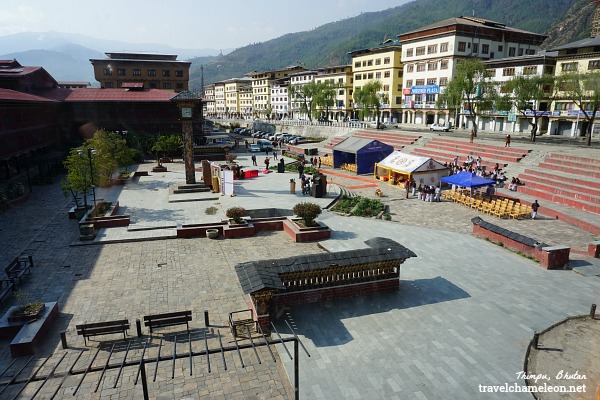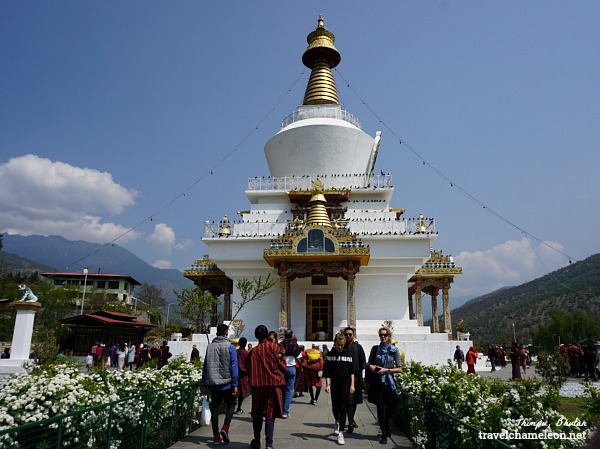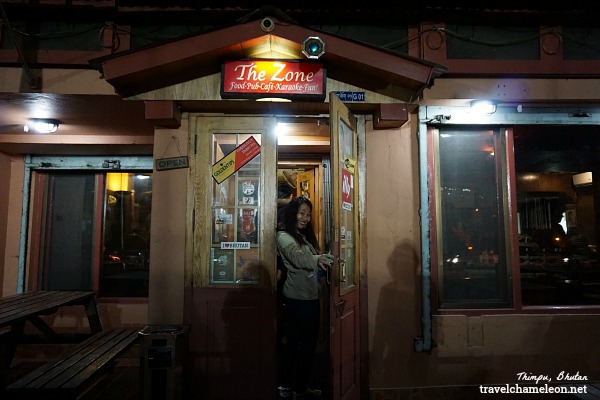Bhutan is one of the best places in the world to see natural green surroundings and mountains overlooking the valleys. It is also known to implement the Gross National Happiness index which measures collective happiness in the Kingdom. The capital city of Bhutan is known as Thimpu, a unique valley and city with an estimated population of 80,000 people.
During our trip to Bhutan, we stayed for 2 days in Thimpu before visiting other places as mentioned by our local guide. According to Dechen (from Dechen Cultural Tours & Trekking), Thimpu is the only capital city without traffic lights. Like other cities in Bhutan, it has no high rise buildings, no malls, and all the houses or buildings come with a traditional design on the outside. This is a mandatory requirement by the Government to maintain the culture element into its architectures.
We were here in April this year, and the weather was very cooling. It was just nice during the day with 17 degrees but dropped lower during the night. Luckily for us, we brought a light jacket to shield ourselves from the cold wind.
We did most of the touristy stuff and also went to places where locals usually hang out. It was nice to be able to experience both, especially when you have a local friend. Here is a summary of where we stayed, ate and visited in this unique valley for 48 hours.
Sleeping in Thimpu Tower Hotel, Bhutan.
Accommodation in Bhutan starts from mid-range to premium and this is why everything comes in a package. There are plenty of places to stay in Thimpu, as it's all within the city center. We were lucky to have stayed in Thimpu Tower Hotel which is just beside the famous Clock Tower Square. We had the second-floor rooms overlooking the area and free breakfast at the ground floor restaurant. It was spacious and came with the view of the shops across the street and the green hills in the background. The hotel is also a walking distance to a few attractions within the city.
 Our first 2 nights in Bhutan was at Thimpu Tower Hotel.
Our first 2 nights in Bhutan was at Thimpu Tower Hotel.
Places to eat in Thimpu.
1. Lunch at Ga-wa Restaurant.
Our lunch came courtesy of the travel package for this Bhutan trip; which was at Ga-Wa Restaurant, one of the best restaurants in the middle of Thimpu Town. It's located at the Clock Tower and less than 2 minutes of walking distance to our hotel. They serve an authentic menu inspired by traditional Bhutanese recipes. We had a four-course meal that included a squash soup, beetroot salad (delicious), the main course of Olio Pasta and caramelized bananas with crepe for dessert. The restaurant looks extremely posh with its red covered plush chairs and large windows for the outdoor view.
 Dining in Ga-Wa Restaurant, in Thimpu Valley.
Dining in Ga-Wa Restaurant, in Thimpu Valley.
2. Trying local dishes at Cousin Restaurant.
On the second day of Thimpu we had lunch in a local place called Cousin Restaurant which served mostly vegetarian and non-pork meals. By the way, Bhutanese generally eat more beef than pork and a lot of cheese in most of their dishes. Restaurants which are often frequented by neighboring country India, usually serves vegetarian options (like this place) and seafood. My favorite Bhutanese dish so far is Kewa Datshi, a combination of cheese and chili which is just so good! It's also easy to make at home
 Enjoying Bhutanese dishes such as Ema Datshi (chili and cheese) & Kewa Datshi (potato and cheese), Cousin Restaurant.
Enjoying Bhutanese dishes such as Ema Datshi (chili and cheese) & Kewa Datshi (potato and cheese), Cousin Restaurant.
3. Dinner FNB Restaurant (for a birthday celebration).
This restaurant is also a walking distance away from the hotel and we had a birthday celebration for Dechen here for dinner. During this time, we met her friends who were all locals and very friendly. They shared stories of local cultures especially on weddings since one of them was about to get married the following month. Bhutanese are generally very warm and pleasant people which made it easy for us to get along when we first met. The Chef prepared local dishes (which we don't know the names since it was all pre-ordered) and presented a carved watermelon dessert for Dechen.
 Celebrating Dechen's Birthday in FNB Restaurant and meeting new Bhutanese friends. The Chef & owner of the Restaurant is seen on far right.
Celebrating Dechen's Birthday in FNB Restaurant and meeting new Bhutanese friends. The Chef & owner of the Restaurant is seen on far right.
Places to visit in Thimpu (as a tourist & as a local).
1. Clock Tower Square.
This was the closest to our hotel, therefore, it was the first of our sightseeing places. It is also a popular venue for formal functions, as seen from the image below. The tower comes with four clock faces in the middle of the square and a traditional prayer wheel which can be seen almost everywhere in Bhutan. The Buddhists believe that turning it brings good luck as the sound from the wheel is like to prayers in the air.
 Locals preparing the tent and stage area for the arrival of a Royal Member who is gracing the event at Thimpu Clock Tower.
Locals preparing the tent and stage area for the arrival of a Royal Member who is gracing the event at Thimpu Clock Tower.
2. The roundabout with no traffic lights.
According to Tenzin, our new local friend, there was a time when the Government placed traffic lights in the city in the 1990s only to have them removed again after many objections from the local. They found it to be impersonal and prefer the conventional way of having a traffic policeman manning the traffic instead. We managed to catch the traffic police in action at the famous small roundabout becoming the human traffic light instead. Even the roundabout had traditional Bhutanese painting on them.
 The traffic policeman manning the roundabout in Thimpu town.
The traffic policeman manning the roundabout in Thimpu town.
3. Local shops in Thimpu.
The streets of Thimpu are lined with traditional looking shop houses selling souvenirs, mini-marts, cobbler, and even a bar. As expected, we saw Bhutanese carvings and painting on these shops as we walked along the streets in Thimpu. There were modern buildings too, with cafes, restaurants and grocery items. We just had to bear in mind that shops in Thimpu close as early as 8 pm as it tends to get much more colder during the night.
 A traditional shop seen in Thimpu.
A traditional shop seen in Thimpu.
4. Statue of Sakyamuni Buddha.
On our second day, we visited the largest sitting Buddha in the world on top of Kuensel Phodrong hill, overlooking Thimpu Valley. The sitting Buddha can be seen from anywhere in this city as a reminder of the religion. The exterior of this area is covered in gold tiles while the inside houses 24,000 Buddha statues. Inside the halls were ceilings painted with intricate mandalas. Bhutanese believe that knowledge will be transferred to anyone standing beneath them.
 The 165 feet tall Buddha Statue overlooking Thimpu Valley.
The 165 feet tall Buddha Statue overlooking Thimpu Valley.
5. The National Memorial Chorten.
We drove all the way up to a hill, stopping at Memorial Chorten to observe pilgrimages making their way around the temple. It was built in 1974 to honor the memory of the beloved third King, the grandfather of the current monarch. The Chorten is the focus of daily worship for the faithful. As we entered the area, we saw giant prayer wheels on the left and followed the devotees around the temple. We saw a prayer hall and an open area where people were seen praying to get rid of ego and pride from their body.
 Lotte drove us to Memorial Chorten to see the pilgrimage making their way around the temple. This Chorten is the daily focus of worship of the locals.
Lotte drove us to Memorial Chorten to see the pilgrimage making their way around the temple. This Chorten is the daily focus of worship of the locals.
6. Takin Sanctuary.
This national animal is a cross between a gnu and a musk deer. It has an immense face, a tremendously thick neck, and short thick legs to support its heavy body. We were unfortunate to not see the Takins in person as the sanctuary was closed for the week. There had been news about Takins dying and the Ministry was in the process of investigating the root of the problem. Our guide Yongten and Lotte drove to another side of the sanctuary where we could see the Takins from far. They were placed here when the King realized that letting them roam free (from the forest to the city) was hazardous to the Takins. He then had this area kept for the animal to roam around the tall, green forest.
 The Takin Sanctuary from the outside of the compound.
The Takin Sanctuary from the outside of the compound.
7. View Thimpu from one of the high points.
On the way to our next destination, we stopped at Sangay Gang to to see Thimpu from above. It was a beautiful sight of flat roofs and colorful walls. To get here, we had to endure wavy roads which is the norm in this valley. There rarely are any straight roads and we had to get used to the constant rocking in our van. If you're not used to this, you might end up with motion sickness, therefore be prepared to take medication to avoid this from happening. Otherwise, you might end up missing views such as this one below.

8. Chang Gangkha Monastery.
Dechen had loaned us her traditional Bhutanese top which we wore to the Chang Gangkha Monastery. It is called a Kira and it is usually worn with a wonju (long-sleeved blouse) on the inside and a short jacket or toego) on the outside. It is common to see Bhutanese wearing their traditional costumes when visiting the monasteries in the Kingdom. This particular one is known as the sacred temple founded by Phajo Dugom in the 13th Century. A lot of parents visit this temple with their children to seek a blessing. We climbed up the small hill to the temple which had prayers wheel around the area. It felt very serene and peaceful.
 My sister and I with our traditional toega (jacket), and Dechen with the full Bhutanese kira.
My sister and I with our traditional toega (jacket), and Dechen with the full Bhutanese kira.
9. Zorig Chusum School of Traditional Arts.
Established in 1971, the school aims for youths in Bhutan to take up skills in traditional arts and crafts. Visitors are allowed to observe the students training in this school, which focuses on preserving the thirteen traditional arts of Bhutan. As we entered the compound, we saw students in different halls and room, concentrating on their work. These included paintings, sculpture, metalwork, carpentry, wood carving, embroidery, masonry, weaving, paper making, leather work, bamboo carving, gold and silver work.
 The Zorig Chusum School preserving the traditional arts of Bhutan.
The Zorig Chusum School preserving the traditional arts of Bhutan.
10. Centenary Farm Market.
We came back to Thimpu town center and visited the Centenary Farm Market which had to parts to it. We went to the dry market area where arts and crafts were sold. We bought a few more magnets and Bart bought himself a traditional Bhutanese costume, called "Gho" and it took people to wear it for him! Across the wet market is the dry market area selling vegetables, meat, spices and all kinds of cheese. We even found a stall selling yak cheese which looked like hanging sausages. Locals love these and chew on them for hours before it dissolves.

11. Changlimithang Stadium.
After visiting the market, we drove over to the historical Changlimithang Stadium where it was used as a battle area during the olden days. Currently, space is being used for archery competition and games by the locals. We watched a group of Bhutanese men in their traditional clothes holding the bow and releasing the arrow to a target that stood more than 2 meters away. In a normal competition, the opponent would stand near the target, jeering his competitor to miss the bullseye. For this reason alone, a man got hit once with an arrow and we decided that the safe zone is the best place to watch this activity up close.
 Bhutanese men taking turns shooting the arrow at the Changlimithang Staidum in Thimpu.
Bhutanese men taking turns shooting the arrow at the Changlimithang Staidum in Thimpu.
12. Post Office Museum
This was not included in our itinerary but since we saw it along the way, we requested a quick stop to see the Post Office Museum. Established in 1962, this post office provides postal services as well as an exhibition on how mails were delivered back then. There was a man who used to send these letters on foot and his statue can be seen inside the museum, standing tall at more than 6 feet. A guide was there to explain a little bit of Royal history, and how the current King came to be where he is today. At the end of the tour was the stationary shop where were could get customized stamps like the one below. Gosh, I'm not sure if I'll ever use these on the postcards because it's such a memorable one.
 Customized stamps at the Thimpu Post Office Museum.
Customized stamps at the Thimpu Post Office Museum.
13. Trashi Chhoe Dzong
We managed to visit Trashi Chhoe Dzong which is one of the many Dzongs, that can be found in Bhutan. This particular one is where the Kings Office is located and it is opened to the public from 5 pm to 6 pm, depending on their schedule. We had to wait for 30 minutes after 5 pm for all the staff to leave before the doors opened. The Kings Palace is located down the Dzong, and the locals had to build a wall to separate the two to avoid tourists from taking photos of the area. This capital administrative building serves as a religious power in Bhutan. The King and the Supreme Religious Leader rule side-by-side to provide for the welfare of their peoples secular and spiritual well being.
 The beautiful Trashi Chhoe Dzong or the Kings Office.
The beautiful Trashi Chhoe Dzong or the Kings Office.
14. Shopping for arts & craft at Thimpu's weekend market.
We had some time in the evening for a little souvenir shopping. This area had a row of thatched roof and stalls selling all things Bhutanese. Most of the sellers were women and they were seen completing the crafts on the spot. there were colorful textiles, bows and arrows, masks, religious artifacts, gongs, paintings, and religious scrolls. We ended up buying magnets, colorful Buddhist flags (for friends), and postcards to send back home.

Experiencing nightlife in Thimpu.
1. Meeting up at The Zone.
On the first night in Bhutan, Dechen brought us to The Zone, a local restaurant and pub with cosy interior with soft, yellow lighting. This is where she and her friends would usually meet up after work or before they head to a party. The Zone serves fish and chips, yak burger, soups, roasted chicken among the Western menu. Although most of the shops here close early, places like this will still be open until close to midnight.
 Catching up with Dechen at The Zone.
Catching up with Dechen at The Zone.
2. Watching live band at Mojo Park.
After celebrating Dechen's birthday at the FNB Restaurant, we walked down to Mojo Park (which is nearby the Zone) for a little live band performance. Many people were already standing outside of this place waiting for their friends. We walked in and found a table near the stage (also near the restroom but no choice since it was packed) and ordered drinks. At first, we sat at the front row sofa but had to move when we were told that it's reserved for a VIP group. We enjoyed watching the performers who sang the latest hits around the world (and they were really good at it).

3. Missing out on clubbing in Viva.
Dechen and her friends continued their night at Viva Club in Thimpu while we decided to head back to the Hotel, exhausted from the early start we had that day. I didn't realize they had clubs here in Thimpu until she pointed it out. There's a part of Bhutan that still maintains its traditional side while another side of it has the modern traits like any other part of the world. This is where the youngsters spend their time with their friends, dancing the night away to good music.
 House music in Viva Club Thimpu.
House music in Viva Club Thimpu.
A closing note on the 48 hours experience in Thimpu.
There were so many places we managed to see within the two days, including those that were not in the tour list. We would have visited more places on the first day if not for the mid-air incident. Nevertheless, it turned out to be a great 2-days visit with plenty of beautiful sceneries and buildings that we managed to capture. The friendly locals also made the entire trip pleasant and we got to know more about our local guides, as we spent more time with them on the road.
In the next post, I will be sharing with you scenes and activities of Punakha, another key city in Bhutan known for its mountainous views.
For more info on our 5D4N itinerary of Bhutan, read here.